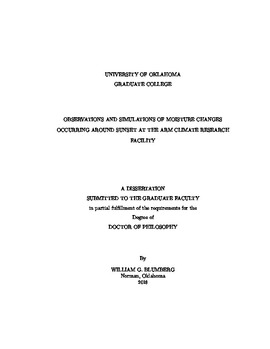| dc.contributor.advisor | Cavallo, Steven | |
| dc.contributor.advisor | Turner, David D. | |
| dc.contributor.author | Blumberg, William Gregory | |
| dc.date.accessioned | 2018-05-22T16:21:29Z | |
| dc.date.available | 2018-05-22T16:21:29Z | |
| dc.date.issued | 2018-05-11 | |
| dc.identifier.uri | https://hdl.handle.net/11244/299948 | |
| dc.description.abstract | Each summer, the U.S. Southern Great Plains (SGP) hosts a variety of ingredients (e.g. moisture, shear, instability, and lift) critical to understanding the life-cycle of deep, moist convection. Past studies have primarily shown that two ingredients undergo substantial changes in the evening hours: shear and instability. While increases in low-level static stability may act to inhibit deep convection, increases in low-level shear may promote the maintenance of convective updrafts. Consideration of only a subset of these ingredients presents an incomplete conceptual model of local, low-level environmental changes that occur during the Afternoon-to-Evening Transition (AET). As various studies of the SGP indicate that the frequency of hazardous thunderstorms begins to increase in the evening hours, consideration of how other ingredients evolve may facilitate additional improvements to convective forecasts.
To improve this conceptual model, a new line of research aims to track the spatiotemporal evolution of water vapor during the SGP AET and understand the processes behind these changes. By using data produced by the Oklahoma Mesonet and Atmospheric Radiation Measurement (ARM) programs, rapid increases (1-4 g/kg) in moisture are found to occur near the SGP Winter Wheat Belt (WWB). In some cases, these jumps in moisture can greatly reverse the loss of conditional instability caused by the setting sun. By using a combined observation and modeling strategy, this study helps clarify the relationships between decaying turbulence and moisture advection on moisture and conditional instability. The results from this study lends support to a conceptual model that in the summertime, the processes occurring during the AET initiate a westward surge in moisture from the eastern boundary of the WWB that may intensify deep, moist convection downstream. | en_US |
| dc.language | en_US | en_US |
| dc.subject | water vapor | en_US |
| dc.subject | afternoon to evening transition | en_US |
| dc.subject | deep, moist convection | en_US |
| dc.subject | Southern Great Plains | en_US |
| dc.title | Observations and Simulations of Moisture Changes Occurring Around Sunset at the ARM Climate Research Facility | en_US |
| dc.contributor.committeeMember | Basara, Jeff | |
| dc.contributor.committeeMember | Shapiro, Alan | |
| dc.contributor.committeeMember | Fagg, Andrew | |
| dc.date.manuscript | 2018-05-11 | |
| dc.thesis.degree | Ph.D. | en_US |
| ou.group | College of Atmospheric & Geographic Sciences::School of Meteorology | en_US |
| shareok.orcid | 0000-0001-7620-7962 | en_US |
| shareok.nativefileaccess | restricted | en_US |
